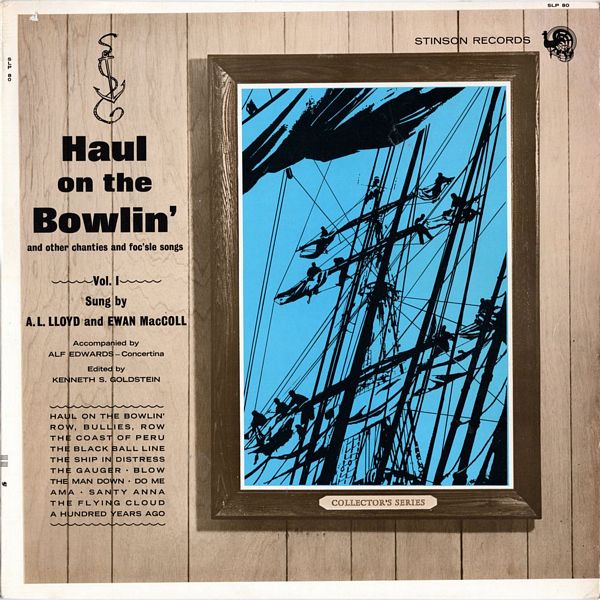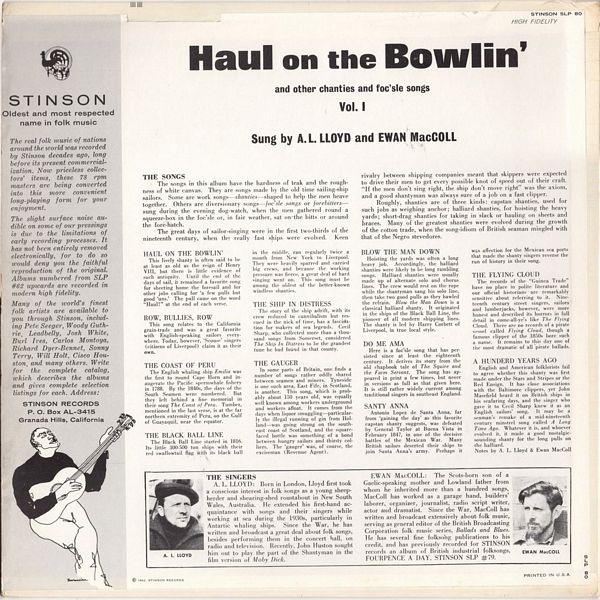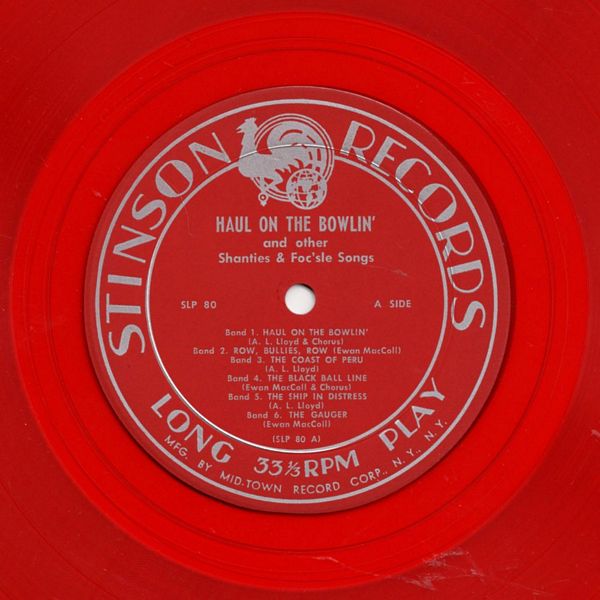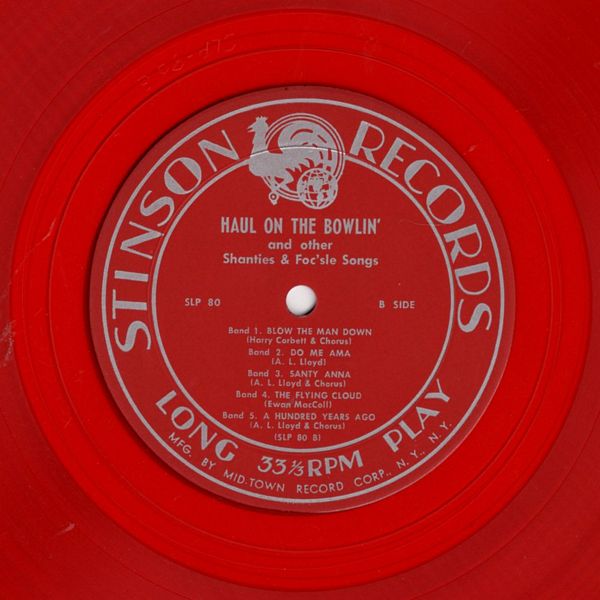

 |


 |
Sleeve Notes
THE SONGS
The songs in this album have the hardness of teak and the roughness of white canvas. They are songs made by the old time sailing-ship sailors. Some are work songs — shanties — shaped to help the men heave together. Others are diversionary songs — foc'sle songs or forebitters — sung during the evening dog-watch, when the men gathered round a squeeze-box in the foc'sle or, in fair weather, sat on the bitts or around the fore-hatch.
The great days of sailor-singing were in the first two-thirds of the nineteenth century, when the really fast ships were evolved. Keen rivalry between shipping companies meant that skippers were expected to drive their men to get every possible knot of speed out of their craft. "If the men don't sing right, the ship don't move right" was the axiom, and a good shantyman was always sure of a job on a fast clipper.
Roughly, shanties are of three kinds: capstan shanties, used for such jobs as weighing anchor; halliard shanties, for hoisting the heavy yards; short-drag shanties for taking in slack or hauling on sheets and braces. Many of the greatest shanties were evolved during the growth of the cotton trade, when the song-idiom of British seaman mingled with that of the Negro stevedores.
HAUL ON THE BOWLIN' — This lively shanty is often said to be at least as old as the reign of Henry VIII, but there is little evidence of such antiquity. Until the end of the days of sail, it remained a favorite song for sheeting home the foresail and for other jobs calling for 'a few pulls but good 'uns.' The pull came on the word "Haul!" at the end of each verse.
ROW, BULLIES, ROW — This song relates to the California grain-trade and was a great favorite with English-speaking sailor? everywhere. Today, however, 'Scouse' singers (citizens of Liverpool) claim it as their own.
THE COAST OF PERU — The English whaling ship Emilia was the first to round Cape Horn and in-augerate the Pacific spermwhale fishery in 1788. By the 1840s, the days of the South Seamen were numbered. But they left behind a fine memorial in their song The Coast of Peru. Tumbez, mentioned in the last verse, is at the far northern extremity of Peru, on the Gulf of Guayaquil, near the equator.
THE BLACK BALL LINE — The Black Ball Line started in 1816. Its little 300-500 ton ships with their red swallowtail flag with its black ball in the middle, ran regularly twice a month from New York to Liverpool. They were heavily sparred and carried big crews, and because the working pressure was fierce, a great deal of hard singing went on. This song must be among the oldest of the better-known windless shanties.
THE SHIP IN DISTRESS — The story of the ship adrift, with its crew reduced to cannibalism but rescued in the nick of time, has a fascination for makers of sea legends. Cecil Sharp, who collected more than a thousand songs from Somerset, considered The Ship In Distress to be the grandest tune he had found in that county.
THE GAUGER — In some parts of Britain, one finds a number of songs rather oddly shared between seamen and miners. Tyneside is one such area, East Fife, in Scotland, is another. This song, which is probably about 150 years old, was equally well known among workers underground and workers afloat. It comes from the days when liquor smuggling — particularly the illegal running of gin from Holland — was going strong on the southeast coast of Scotland, and the square-faced bottle was something of a bond between hungry sailors and thirsty colliers. The 'gauger' was, of course, the exciseman (Revenue Agent).
BLOW THE MAN DOWN — Hoisting the yards was often a long heavy job. Accordingly, the halliard shanties were likely to be long rambling songs. Halliard shanties were usually made up of alternate solo and chorus lines. The crew would rest on the rope while the shantyman sang his solo line, then take two good pulls as they bawled the refrain. Blow the Man Down is a classical halliard shanty. It originated in the ships of the Black Ball Line, the pioneer of all modern shipping lines. The shanty is led by Harry Corbett of Liverpool, in true local style.
DO ME AMA — Here is a foc'sle song that has persisted since at least the eighteenth century. It derives its story from the old chapbook tale of The Squire and the Farm Servant. The song has appeared in print a few times, but never in versions as full as that given here. It is still rather widely current among traditional singers in southeast England.
SANTY ANNA — Antonio Lopez de Santa Anna, far from 'gaining the day' as this favorite capstan shanty suggests, was defeated by General Taylor at Buena Vista in February 1847, in one of the decisive battles of the Mexican War. Many British sailors deserted their ships to join Santa Anna's army. Perhaps it was affection for the Mexican sea ports that made the shanty singers reverse the run of history in their song.
THE FLYING CLOUD — The records of the "Guinea Trade" have no place in polite literature and our official historians are remarkably sensitive about referring to it. Nineteenth century street singers, sailors and lumberjacks, however, were more honest and described its horrors in full detail in come-all-ye's like The Flying Cloud. There are no records of a pirate vessel called Flying Cloud, though a famous clipper of the 1850s bore such a name. It remains to this day one of the most dramatic of all pirate ballads.
A HUNDERD YEARS AGO — English and American folklorists fail to agree whether this shanty was first made under the Stars and Stripes or the Red Ensign. It has close associations with the Baltimore clippers, yet John Masefield heard it on British ships in his seafaring days, and the singer who gave it to Cecil Sharp knew it as an English sailors' song. It may be a seaman's remake of a mid-nineteenth century minstrel song called A Long Time Ago. Whatever it is, and whoever evolved it, it made a good nostalgic-sounding shanty for the long pulls on the halliard.
Notes by A. L. Lloyd & Ewan MacColl
THE SINGERS
A. L. LLOYD: Born in London. Lloyd first took a conscious interest in folk songs as a young sheep-herder and shearing-shed roustabout in New South Wales. Australia. He extended his first-hand acquaintance with songs and their singers while working at sea during the 1930s, particularly in Antarctic whaling ships. Since the War. he has written and broadcast a great deal about folk songs. besides performing them in the concert hall, on radio and television. Recently. John Huston sought him out to play the part of the Shantyman in the film version of Moby Dick.
EWAN MAcCOLL: The Scots-born son of a Gaelic-speaking mother and Lowland father from whom he inherited more than a hundred songs, MacColl has worked as a garage hand, builders' laborer, organizer, journalist, radio script writer, actor and dramatist. Since the War, MacColl has written and broadcast extensively about folk music. serving as general editor of the British Broadcasting Corporation folk music series, Ballads and Blues. He has several fine folksong publications to his credit, and has previously recorded for STINSON records an album of British industrial folksongs. FOURPENCE A DAY, STINSON SLP #79.